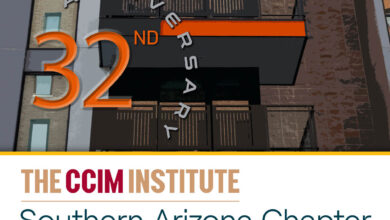
7. Downtown Revitalization
By Jay Gonzales
In the simplest characterization of the revitalization that has taken place in Downtown Tucson, it was like someone with patience and a vision lined up 1,000 dominoes then watched them fall.
Since about 2018, when the AC Hotel by Marriott opened as the first new hotel built downtown since the early 70s, Downtown Tucson has gone from a central core dominated by government offices and deserted streets at night to a thriving urban center.
People are working, living and playing there.
How the revitalization came together wasn’t rocket science, but it had order and it took vision, said Fletcher McCusker who, as the board chair for Rio Nuevo, has played a major role in what has become a reason the world is watching Tucson.
In the many rankings Tucson has received for its livability, cuisine and activities, downtown is a contributing factor.
“I would say it’s all organic, but it’s not the result of any genius master plan on our part,” McCusker said. “A number of things contributed to it.”
It started with a new hotel, the AC Hotel’s opening in 2018 as the first hotel to open downtown since 1973. Then came the restaurants. Then came the housing. Each of those was like a domino that led to another one falling, then another, then another until our downtown came to life.
“Food and beverage is contagious,” McCusker said. “Once you have a really cool spot, that attracts another cool spot, and that attracts another cool spot. Downtown has become the foodie destination for Tucson.
“Same thing with hotels. Once one hotel opens, everybody’s got to have a hotel. The AC Marriott attracted Hilton and the Doubletree and the Hyatt and the Moxie. And then at some point people wanted to live there. Developers have been surprised with the demand for these urban apartments. They lease up in the pre-construction phase.”
As fascinating as anything about downtown are the demographics of who’s coming there to play and who’s living there, McCusker said.
“Half of them are ‘baby boomers’ who want to live in an urban environment, walk to restaurants and go to the symphony and the ballet,” he said, “and the other half are millennials who Uber everywhere.”
Developers and investors have not been shy about making a move downtown.
The Tucson Convention Center just put the finishing touches on a 10-year, $100 million renovation with the City of Tucson, Rio Nuevo and a private developer funding it. Hilton built a Doubletree Hotel on the property that opened in 2021.
Hundreds of millions of dollars have been invested in housing developments in the core of downtown as well as in the Mercado District, west of Interstate 10.
HSL Properties leveled the old La Placita Village office and retail complex north of the TCC to build a 243-unit residential complex called The Flin. The Gadsden Company has built a 122-unit development, The Monier, at Mercado. The $110 million Bautista development, a combination of commercial, food and beverage space with 256 residential units, broke ground last year and is expected to be completed in 2025.
The COVID-19 pandemic came at a time that a number of the developments were already in the works and/or under construction. It slowed some of the projects getting finished, but not the enthusiasm for investing in downtown.
“We always knew that we’d be able to get through it,” Adam Weinstein, president and CEO of The Gadsden Company, told BizTucson in 2022. “I think it was just a matter of how much of a delay this was ultimately going to
cause, and making sure that we were in a strong position to be able to cover all of these circumstances and be able to move forward.”
There’s more to come, McCusker said. But it’s not too far into the distant future when Rio Nuevo’s work will be done, he said.
The tax increment financing that funds Rio Nuevo and therefore funds many of the Downtown projects, is set to expire in 2035. A decision hasn’t been made on trying to extend it again.
In the meantime, the Rio Nuevo District, which actually includes properties east on Broadway all the way to Wilmot Road, will see more development, McCusker said. Because of all the new business in the downtown portion of the Rio Nuevo District, about $20 million a year is coming in for investment in the district, but the land will eventually run out.
“You still have the far west side. That’s gonna build out eventually,” he said. “You’re going to start seeing infill in pretty much every vacant lot between Downtown and Wilmot. You’re gonna see rapid transit and maybe trolleys, bike lanes, Rideshare, pull-throughs. I think that’ll all happen in the next four or five years and then Rio Nuevo will be done.”






